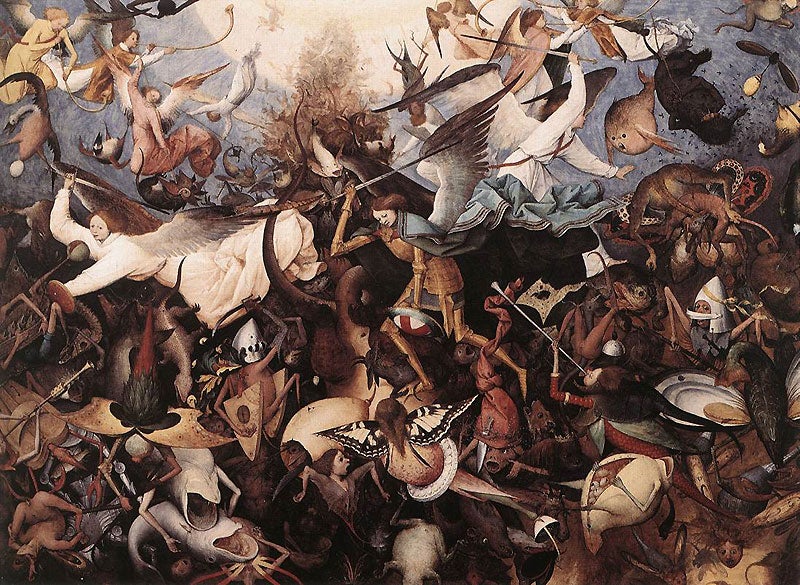Bruegel, Pieter: The Fall Of The Rebel Angels (1562)
The Independent's Great Art series

"The reason Milton wrote in fetters when he wrote of Angels & God, and at liberty when of Devils & Hell, is because he was a true Poet, and of the Devil's party without knowing it." That was William Blake's view of Milton's Paradise Lost. Is the same true of Bruegel – a true artist, and on the Devil's side?
At first it seems unlikely. Look at his Fall of the Rebel Angels. Milton's fallen angels have grandeur and dignity in their defiance. They have ranks and echelons. They have some sort of human form. Bruegel's fallen angels are an appalling shower.
Falling from grace, they have lost their angelic natures and turned into a menagerie of yucky, hybrid critters and beasties. Bizarre, absurd, unpleasant things, they seem neither powerfully dangerous nor deeply evil. They are essentially ridiculous. It is a most unromantic embodiment of sin. Who could be tempted by a devil half-made of seafood?
They plunge in a fizzing swarm, like anti-moths, away from the disc of divine light. They spread out to fill the whole lower half of the picture in a dense and chaotic throng. At the bottom right corner they're being sucked down a fiery plughole to hell.
Bruegel presents these devils as a domestic nuisance, an infestation. The "war in heaven" is a hygiene operation. The task of St Michael, the skinny golden knight, and his fellow loyal angels in white robes, is the kind of disgusting, necessary job that might confront any countryman or town dweller – getting rid of a plague of vermin, beating the things out, driving them away.
But the story isn't straightforward. Bruegel is an artist who believes in multitudes and masses more than individual figures. This seething infestation of devils is pictorially more than a match for the handful of squeamish-looking beaters with their tiny shields held at arm's length. It's full of energy, and imaginative energy, too.
What an eyeful! It's an extraordinary miscellany, made of scattered bits of the world – sea creatures, butterflies, poultry, armoured knights, tentacles, tails, eggs and fruit. You can pick out an inflated puffer fish, a sycamore seed, a mushroom cup, a skeleton.
It's natural to think of an earlier artist, Hieronymus Bosch. His work was clearly an inspiration to Bruegel. But the similarity holds a big difference. It's the difference between two kinds of fantasy art. One is devoted to sheer invention. The other brings its inventions to life.
Bosch's phantasmagoria have casts of thousands. He has an endless ability to make things up, to coin weird and queasy combinations. But his creatures remain figments of his imagination. Looking at them, you think of the mind that so ingeniously devised them. Looking at Bruegel's, you think of the creatures themselves.
What Baudelaire said of Goya is also true of Bruegel: "Goya's great merit consists of making the monstrous plausible. His monsters were born viable. Nobody has managed to surpass him for a sense of the possible absurd. All these contortions, these bestial faces, these diabolical grimaces are pierced with humanity."
Bruegel's monsters, more monstrous than Goya's, have life burgeoning in them– yelling, writhing, growling, colliding. The struggle of wild, revolting devils against lean, dainty, tidying angels, is the kind confrontation Bruegel is often drawn to: fat vs thin, gluttons vs prudes. He's not quite of the Devil's party, but he can certainly feel with both sides.
The artist
Pieter Bruegel the Elder (c1525-1569) is one of the world's most postered painters. Hunters in the Snow, The Peasant Wedding, The Fall of Icarus or The Tower of Babel are stuck to walls everywhere. The Netherlandish artist's work has become part of our visual vocabulary – quotable, proverbial, almost anonymous. Bruegel comes across as an inherently democratic painter, part of popular, not elite, culture. He embraces all of life, effortlessly combining comic and tragic. He's a crowd pleaser and his art delights in teeming crowds.
Join our commenting forum
Join thought-provoking conversations, follow other Independent readers and see their replies
Comments
Bookmark popover
Removed from bookmarks